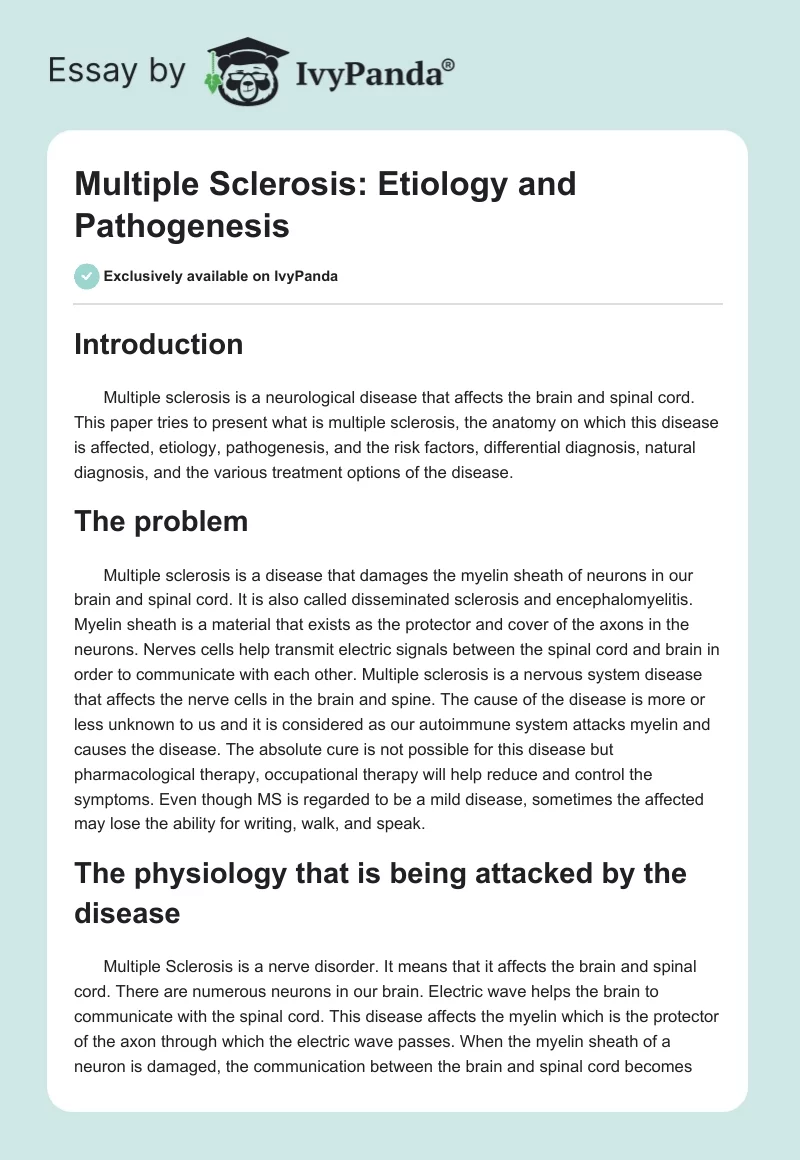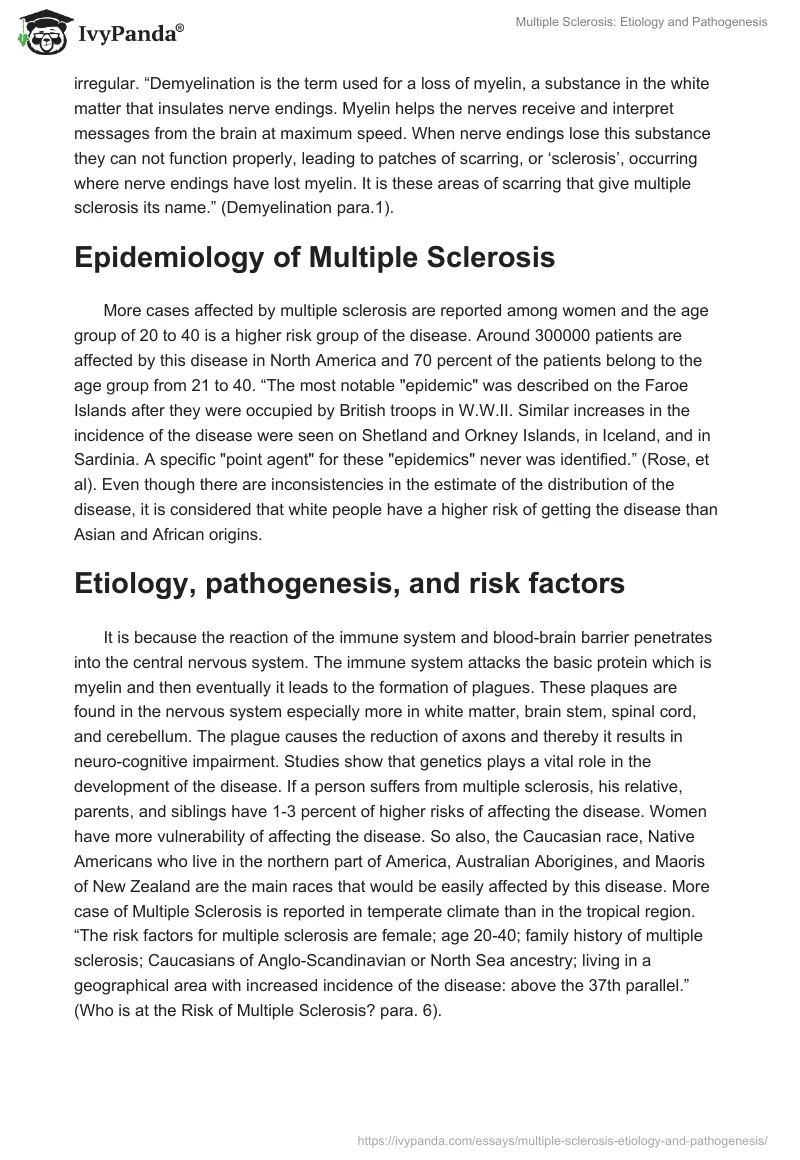Introduction
Multiple sclerosis is a neurological disease that affects the brain and spinal cord. This paper tries to present what is multiple sclerosis, the anatomy on which this disease is affected, etiology, pathogenesis, and the risk factors, differential diagnosis, natural diagnosis, and the various treatment options of the disease.
The problem
Multiple sclerosis is a disease that damages the myelin sheath of neurons in our brain and spinal cord. It is also called disseminated sclerosis and encephalomyelitis. Myelin sheath is a material that exists as the protector and cover of the axons in the neurons. Nerves cells help transmit electric signals between the spinal cord and brain in order to communicate with each other. Multiple sclerosis is a nervous system disease that affects the nerve cells in the brain and spine. The cause of the disease is more or less unknown to us and it is considered as our autoimmune system attacks myelin and causes the disease. The absolute cure is not possible for this disease but pharmacological therapy, occupational therapy will help reduce and control the symptoms. Even though MS is regarded to be a mild disease, sometimes the affected may lose the ability for writing, walk, and speak.
The physiology that is being attacked by the disease
Multiple Sclerosis is a nerve disorder. It means that it affects the brain and spinal cord. There are numerous neurons in our brain. Electric wave helps the brain to communicate with the spinal cord. This disease affects the myelin which is the protector of the axon through which the electric wave passes. When the myelin sheath of a neuron is damaged, the communication between the brain and spinal cord becomes irregular. “Demyelination is the term used for a loss of myelin, a substance in the white matter that insulates nerve endings. Myelin helps the nerves receive and interpret messages from the brain at maximum speed. When nerve endings lose this substance they can not function properly, leading to patches of scarring, or ‘sclerosis’, occurring where nerve endings have lost myelin. It is these areas of scarring that give multiple sclerosis its name.” (Demyelination para.1).
Epidemiology of Multiple Sclerosis
More cases affected by multiple sclerosis are reported among women and the age group of 20 to 40 is a higher risk group of the disease. Around 300000 patients are affected by this disease in North America and 70 percent of the patients belong to the age group from 21 to 40. “The most notable “epidemic” was described on the Faroe Islands after they were occupied by British troops in W.W.II. Similar increases in the incidence of the disease were seen on Shetland and Orkney Islands, in Iceland, and in Sardinia. A specific “point agent” for these “epidemics” never was identified.” (Rose, et al). Even though there are inconsistencies in the estimate of the distribution of the disease, it is considered that white people have a higher risk of getting the disease than Asian and African origins.
Etiology, pathogenesis, and risk factors
It is because the reaction of the immune system and blood-brain barrier penetrates into the central nervous system. The immune system attacks the basic protein which is myelin and then eventually it leads to the formation of plagues. These plaques are found in the nervous system especially more in white matter, brain stem, spinal cord, and cerebellum. The plague causes the reduction of axons and thereby it results in neuro-cognitive impairment. Studies show that genetics plays a vital role in the development of the disease. If a person suffers from multiple sclerosis, his relative, parents, and siblings have 1-3 percent of higher risks of affecting the disease. Women have more vulnerability of affecting the disease. So also, the Caucasian race, Native Americans who live in the northern part of America, Australian Aborigines, and Maoris of New Zealand are the main races that would be easily affected by this disease. More case of Multiple Sclerosis is reported in temperate climate than in the tropical region. “The risk factors for multiple sclerosis are female; age 20-40; family history of multiple sclerosis; Caucasians of Anglo-Scandinavian or North Sea ancestry; living in a geographical area with increased incidence of the disease: above the 37th parallel.” (Who is at the Risk of Multiple Sclerosis? para. 6).
The signs and symptoms of Multiple sclerosis
The signs of Multiple sclerosis are the following “visual disturbances, muscle weakness, trouble with coordination and balance, sensations such as numbness, prickling, or “pins and needles and thinking and memory problems.” (Other Health Topics: Multiple Sclerosis, para. 2). The common symptoms of multiple sclerosis are tiredness, numbness, dysfunction of bladder system, bowel dysfunction, dizziness, sexual dysfunction, cognitive and emotional problems, feeling of pain, depression, bowel dysfunction, speech disorganization, difficulty in swallowing, headache, loss of hearing, problems in breathing and itching. Sometimes multiple sclerosis becomes complicated resulting in blindness and paralysis.
Differential diagnosis
Post-infectious encephalomyelitis which is the result of the response of the autoimmune system to viral infection can be one of the differential diagnoses. Central Nervous System Vasculitis, Lyme disease, Systemic Lupus Erythematosus, Tropical spastic Paraparesis, Behcet syndrome, Sarcoidosis and Sjogren’s syndrome, Vitamin B-12 deficiency, and Tertiary syphilis, leukodystrophies of adulthood, hereditary degenerative disorder, progressive multifocal Leukoencephalopathy are the major differential diagnosis of multiple sclerosis. “inflammatory (systemic lupus erythematosus, Sjögren’s syndrome, vasculitis, sarcoidosis, Behçet’s disease), infectious (Lyme disease, syphilis, progressive multifocal leukoencephalopathy, HTLV-1 infection, herpes zoster), genetic (lysosomal disorders, adrenoleukodystrophy, mitochondrial disorders, CADASIL), metabolic (vitamin B12 deficiency), neoplastic (CNS lymphoma) and spinal (degenerative and vascular malformations) diseases.” (Trojano & Paolicelli para.1).
Natural history of Multiple sclerosis
It becomes a neurological disease and studies show that around sixty percent of people who have multiple sclerosis lead to the neurological illness. There is no alteration in the life expectancy of multiple sclerosis patients in the beginning stages of the disease. “The rate of suicide has been reported to be increased sevenfold in MS patients. Up to 40% of patients with attacks severe enough to render them nonambulatory may not recover. At 15 years from MS onset, 50% of patients are disabled to the point at which they at least require a cane to walk a half block. Early age at onset, female sex, the relapsing-remitting course at onset, and perhaps optic neuritis or sensory symptoms at onset and relatively few attacks in the first two years are associated with a favorable course.” (Neurol para.1).
Treatment for multiple sclerosis
No treatment can result in the complete cure out of multiple sclerosis. But there are a number of treatment options to slow down the effects of the disease. They are pharmacological therapy, chemotherapy, deep brain stimulation, plasmapheresis, and alternative therapy.
Chemotherapy
It is used in the treatment of multiple sclerosis in a way that it makes damages white blood cells. White blood cells attack the myelin in the nervous system that protects the axon. When the white blood cells are destroyed, it would help slow down the reaction of the immune system. Therefore chemotherapy is useful to halt the severity of multiple sclerosis.
Deep brain stimulation
It has three components in the treatment. This process includes a thin wire of electrodes implanted in the brain. The insulated wire connects the lead to the internal pulse generator. IPG is a neuron-stimulator that is implanted in the chest. This treatment for multiple sclerosis will not cure completely but it can slow down the progress. It usually helps to control the tremor in the head and body.
Pharmacological therapy
A number of medicines are used in the management and control of multiple sclerosis. The most used medicines are Antivert, Bonamine, Atarax, Avonex, Cymbalta, Dantruim, Detrol, Elavil, and Paxil.
Plasmapheresis
This treatment involves the process of withdrawing whole blood from the person, removal of liquid portion plasma from the blood and its replacement, and the blood that contains white cells is transfused back into the person and this is very effective in dealing with the patient of multiple sclerosis. It removes all the antibodies from the blood that would lead to the severity of the problem.
Rehabilitation
Rehabilitation is very effective in the treatment of MS patients. Rehabilitation includes a set of therapies. They are physical therapy, occupational therapy, speech therapy, cognitive therapy, and vocational therapy.
Alternative medicine
There are a number of factors that precipitate the disease such as environmental factors, genital factors, and dietary factors. So, it includes various interventions such as adequate exercise, schedule of diet, strategies for stress management, biofeedback, acupuncture, and various therapies. There can be the integration of all these various treatments that would reduce the severity of the problem. Patients respond variously to different treatments. So the best treatment for multiple sclerosis is according to the reaction of the patients towards the different treatment methods.
Conclusion
Even though there are a number of treatment options for Multiple sclerosis, there is no absolute cure. Some parts of the world and some races are higher-risk groups. There are environmental factors, genetic factors, and dietary factors that lead to the problem. The treatment can slow down the hardness of the problem. This paper gives a glance at multiple sclerosis and its different aspects.
Works Cited
Demyelination. Multiple Sclerosis International Federation. 2009. Web.
Neurol, Ann. Natural History of Multiple Sclerosis. PubMed.gov. 1994. Web.
Other Health Topics: Multiple Sclerosis. Medline Plus. 2009. Web.
Rose, John W., et al. Lectures: Epidemiology and Prevalence: Geographic Distribution.Multiple Sclerosis. Web.
Trojano, M., & Paolicelli, D. The Differential Diagnosis of Multiple Sclerosis: Classification and Clinical Features of Relapsing and Progressive Neurological Syndromes. PubMed.gov. 2009. Web.
Who is at the Risk of Multiple Sclerosis? Health-Cares.net. 2005. Web.


